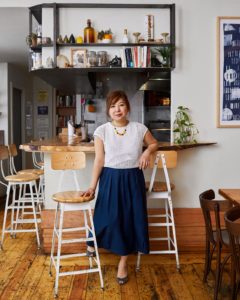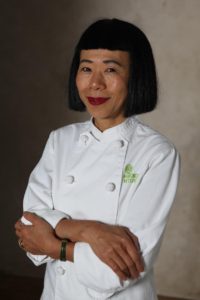There’s no single recipe for sexism in the restaurant industry

Photo Credit: Jill Ryan
By Jill Ryan May 2019
Her father always thought the restaurant industry was too rigorous for girls.The work was too hard and she would never want to do it.
And Maiko Kyogoku believed him.
Born and raised in New York City, Kyogoku had always been familiar with the grueling restaurant industry. She watched as her father, who was originally from northern Japan, endured endless hours of work at his sushi restaurant Rikyu, on the Upper West Side.
She was in her early twenties when her father’s comments were said. They were off-hand, casual and did not faze Kyogoku. Yet, his comments stuck with her; bothered her, as the years went on.
“I think that it’s complicated…I think he essentially was saying it as a concerned father,” Kyogoku said. “But I also feel like that if I were his son, maybe he wouldn’t have said those things.”
The food industry was in her blood and she eventually went against her dad’s wishes. She is now the owner of Bessou, a Japanese restaurant in NoHo.
“It was so significant for me in some way that ‘I did it anyway,’ against his words of advice,” Kyogoku said.
But her father’s comments were mere warning signs of what was to come from other chefs. Way before she became an owner, Kyogoku worked at a very traditional Japanese restaurant and was making Tskune, a Japanese meatball. As she brought them over to the fryer, the head chef stopped her.
“He made a comment about how those meatballs weren’t as perky as my breasts and everyone in the kitchen laughed,” Kyogoku said.
As Kyogoku retold this story, she sat straight up in her chair and had a stern but wise expression on her face.
“I never went back there,” Kyogoku said.
Not Alone
She is not alone. Many women in Japanese cuisine face sexism, often fueled by the old-fashioned values imbedded into Japanese culture. (See Sidebar). Hiroko Shimbo is a world renowned chef consultant and award-winning recipe cookbook author. She was born in Kanazawa, Japan, grew up in Tokyo.
“The woman was traditionally a second citizen, a kind of slave,” Shimbo said. “The woman should get married and should support their husband.”
In her early twenties, before she began her culinary career, Shimbo was single. To shame her, her co-workers began to call her “Christmas Cake.”
“Back then, women who didn’t get married at the age of 25 were considered ‘Christmas Cake,’” Shimbo, calm and collected, continued. “Nobody buys [that cake] after the Christmas date. So everyone at the office says ‘oh you are so Christmas cake why don’t you find someone to get married?’”
She quit.
It wasn’t until years later that she was freed from the culture she grew up in. She moved to America.
“The interesting thing is, American culture let me do more [of what] I wanted to do,” Shimbo said. “If I’m in Japan, I’m stuck in a woman’s role. But because I came here…that’s why I could do so much as a woman, chef consulting, I couldn’t do this if I had stayed in Japan.”
Kyogoku says Japan is one of many countries in Asia that has a reputation for gender inequality.
“It comes back to this kind of archaic societal stereotypes towards women,” Kyogoku said.
Not many chefs are women
In America, when you walk into a Japanese, or specifically sushi restaurant, what gender are the chefs?
Usually men.
This visible phenomenon happens for a few reasons, says Dr. Margarita Estevez-Abe. She is a political scientist who specializes in Japan, political economy, and gender, at Syracuse University.
Japan does not have many female chefs, she says, because many types of Japanese cuisine, such as sushi, aren’t taught in schools; you acquire the skill through apprenticeship.
“The people who pick apprentices tend to be men, and tend to prefer younger men to younger women because they may think younger women may just quit when they get married and… become mothers.”
Even women who do not have, or wish to have children, other obstacles lie in wait.
“I’ve heard some say that women would not make good chefs because their menstrual cycles affected their taste buds—hence their abilities to be chefs,” Estevez-Abe said. “I don’t have any scientific citation for this.”
But both Estevez-Abe and Kyogoku agree, sexist behavior in the food industry is not isolated to Japanese cuisine; it is everywhere.
“The kitchen is so male dominated that there’s no place for a woman,” Kyogoku said.
Sexism
Made with Visme Infographic Maker
(Wave over graph for more information. Data gathered from the NYTimes.)
The chef profession in America is considered to be male-dominated by the United States Department of Labor. Women only make up 21.6 percent as of 2016, according to Data USA.
However, that is higher percentage than most other countries. In the UK, the Independent reports that women make up only 18.5 percent of the over 250,000 professional chef positions.
When you compare who receives Michelin Stars, one of the highest awards a chef can earn, women are not often the recipients. In France, out of th 57 restaurants that were recognized in 2018, only two had female chefs, according to the New York Times. Out of the 621 Michelin Stars that France has won overall, only 16 had female chefs. In Spain, only 19 out of 195. In the U.S. 20 out of 166. And Italy, barely higher than America but with the highest percentage–12.06 percent or 44 out of 365.
America is among the top leading countries closing the gender gap, but it has much more room to grow. Shimbo says the kitchen is a “macho” environment.
“It is very true that in any kitchen you work, in the Japanese, in the French, in Italian, the kitchen environment is very macho,” Shimbo said. “Here in America, in the kitchen, the male still dominates because the thing they do is very macho.”
Shimbo is referring to the hard labor it takes to run a kitchen.
Barbara Sibley is a chef and owner of La Palapa Cocina Mexicana, a Mexican restaurant in the East Village. She was born and raised in Mexico City until she came to America at 15. And when she had 20 plus years of restaurant experience under her belt, she decided to open La Palapa.
“When I went to the landlord to sign the lease for the space [in 2000] with my then business partner, the landlord said to us ‘what if the girls can’t pay the rent?’” Sibley paused, almost shocked by her own words.
She stayed.
“I’ve proven myself to be a great tennant…we’re on our almost 20th year,” Sibley said, “but that [back then] was the attitude, ‘what if the girls couldn’t pay the rent.’”
She, like many women in the hospitality industry, are a part of the New York Chapter “Les Dames d’Escoffier,” an international invitation-only organization to help women in the industry climb the ladder and succeed in a male-dominated field.
Sharon Franke, the president of the New York Chapter, says the organization was founded in 1973 and is continuing to grow across the country as well as around the world.
She hopes that organizations like Les Dames d’Escoffier, will create an environment where women support other women in the culinary industry.
“When I was first starting my career, right after culinary school I interviewed at La Caravelle restaurant, which at the time was one of the top restaurants in New York. Of course it was French and it had a classic French chef and he interviewed me in the restaurant and after the interview he said point blank ‘I won’t hire you because you are a woman.’”
The industry is not made for girls–Kyogoku’s father once said. Now, Kyogoku and her younger sister, Yuki, have both gone into the food industry, and at this point, their father is proud.
“Not only is he okay with it but…he’s also my biggest cheerleader,” she says happily.
Now her father is putting his money where his mouth is.
“He’s my main investor,” Kyogoku said.
Japanese History that Fueled Sexism in its Food Industry
Made with Visme Infographic Maker
Japanese culture is long and complicated. While it developed in a mostly isolated state, Japan became heavily influenced by outside sources in the 1800s. Eva Nagase is a professor at Stony Brook University and her research focuses on Japanese culture.
She says that Japan’s strict modern day divide in gender roles was mostly developed in the Meiji era [1868-1912], the period after the Edo era, when Japan isolated itself for over 200 years from the rest of the world.
“The Japanese government…really wanted to incorporate western ideas…so this Victorian idea of home, they didn’t have that, it was different,” Nagase said.
The family structure prior to that was a head of household, and the wife or wives. But Nagase says the difference was that the women had jobs.
“When Japan got the Victorian idea…they started immediately taking a liking for this family orientation,” Nagase said. “So men’s role, women’s role, it was very very clearly divided and it has been carried on pretty strictly.”
Women began to stay home and Nagase says they even created a title: Professional Housewives.
“Up until the [Meiji/Victorian era] there was no title for a woman working in the house. It was just a wife,” Nagase said. “But now in the Meiji era, they had this title, Master Wife, and they even came up with a slogan, which is ‘Ryōsai Kembo.’ [yo-sigh-kim-bo]. ‘Ryōsai’ is ‘good wife.’ ‘Kembo’ that is ‘wise mother.’”
Women, Nagase says, learned to respect the notion that homes were where they should be.
It’s very difficult to leave that sort of idea behind,” Nagase said. “I think somewhere in the back of their heads they have this idea of Ryōsai Kembo.”
About the Story
Whenever I walked inside a Hibachi restaurant, I always noticed the chefs were always men, while the servers were mostly women. It got me thinking that I had never seen a female Hibachi chef, and I wanted to know why.
After months of reporting and research, it turned out that it had everything to do with Japanese culture and traditions. And I also found that female chefs in other cuisines, and around the world, face similar obstacles. With the help of Make Kyogoku and other women in the food industry, I was able to learn what it takes to be a woman chef.
Photo Credits:
Hiroko Shimbo photo: courtesy of Hiroko Shimbo
Maiko Kyogoku photo: courtesy of Maiko Kyogoku
Barbara Sibley photo credit: Jill Ryan
Sharon Franke photo credit: courtesy of Sharon Franke




